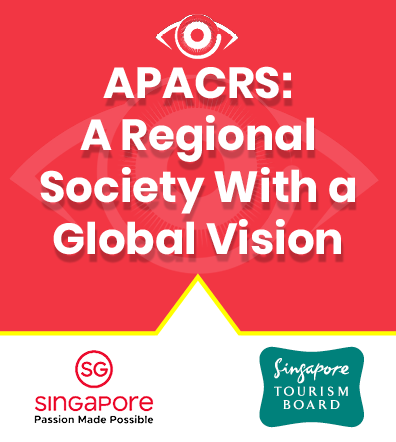Eyeworld Weekly Update |
Volume 14, Number 9 |
17 March 2009 |
- MembraneBlue okayed for vitrectomy procedures
- DME Phase II trial enrollment completed
- Eye care indirectly linked to healthcare coverage
- B&L, Santen in IOL development licensing agreement
- SPATA7 identified as "major" player in childhood blindness
- Mexico grants marketing approval to tonometer
- Inspire to study AzaSite for blepharitis
MembraneBlue okayed for vitrectomy procedures
The US Food and Drug Administration (FDA) has granted its first approval to a staining agent for use in vitrectomy, the Dutch Ophthalmic Research Center International (Exeter, NH, USA) said in a press release. The FDA's approval of MembraneBlue 0.15% (trypan blue ophthalmic solution) will help "by staining the epiretinal membranes during vitrectomy procedures thereby facilitating removal of the tissue."MembraneBlue is supplied in sterile, single use, 2.25 mL syringes filled to a volume of 0.5 mL. Since 2004, VisionBlue 0.06% (trypan blue ophthalmic solution, Dutch Ophthalmic Research Center International), has been the only FDA-approved stain for the anterior capsule of the lens during capsulorhexis. MembraneBlue is a sterile solution of trypan blue (an acid di-azo group dye), the company said. MembraneBlue 0.15% selectively stains epiretinal membranes during ophthalmic surgical vitrectomy procedures. It is intended to be applied directly on the areas where membranes could be present, staining any portion of the membrane which comes in contact with the dye, the group said.
DME Phase II trial enrollment completed
A Phase II trial of microplasmin intravitreal injection for the treatment of diabetic macular edema (DME) has completed patient enrollment, developer ThromboGenics (Brussels, Belgium) said in a press release. This trial—dubbed MIVI II DME—will evaluate the utility of microplasmin in patients with diabetes. MIVI II DME is a randomized, double masked, sham injection controlled, dose ascending clinical trial evaluating the safety and initial efficacy of intravitreal microplasmin for the treatment of patients with diabetic macular edema. The trial is primarily intended to evaluate safety in this specific patient population, but will also assess efficacy by measuring the induction of posterior vitreous detachment (PVD). The trial has recruited over 50 patients across Europe. Patients will be followed for 12 months, with first unmasked data analyzed after six months follow-up, ThromboGenics said.Eye care indirectly linked to healthcare coverage
Individuals with no or inconsistent healthcare coverage appear less likely to regularly seek eye care, according to a study in Archives of Ophthalmology. Eye disorders have an estimated economic impact of more than US$51 billion annually in the United States, the article said. Recommendations for periodic eye examinations vary across ocular and medical organizations, but most recommend one- to two-year screening intervals depending on age and ocular risk factors. David J. Lee, PhD, University of Miami Miller School of Medicine, FL, USA, and colleagues analyzed data from almost 290,000 individuals who participated in the National Health Interview Survey from 1997 through 2005. These adults age 18 and older reported whether they were visually impaired and whether they had seen an eye care professional in the previous year, along with sociodemographic information such as age, sex, education level, family income, and insurance status. The group found 58.3% who were severely visually impaired, 49.6% with some visual impairment and 33.7% of those without visual impairment sought eye care the previous year. Those without healthcare, however, sought eye care in significantly lower percentages: 36% of the severely impaired, 24% of those with some impairment and 14% for those without visual impairment. Socioeconomically, lower rates of eye care use was associated with no visual impairment, lack of health insurance, male sex and low education.B&L, Santen in IOL development licensing agreement
Bausch & Lomb (B&L, Rochester, NY, USA) has obtained the rights to Santen's hydrophobic acrylic polymers to use in development of future IOLs, B&L said in a statement. Santen (Napa, CA, USA) reserves the right for use of the materials in the Japanese market. Financial terms were not disclosed.SPATA7 identified as "major" player in childhood blindness
Researchers with McGill Ocular Genetics Laboratory at the Montreal Children's Hospital of McGill University Health Centre, Canada, and elsewhere have identified a link between the retinal gene SPATA7 and Leber congential amaurosis (LCA) and retinitis pigmentosa. Earlier research had identified 14 genes involved in LCA, but SPATA7 is the first gene with a mutation that disrupts the protein transport between two important compartments of the cell—the endoplasmic reticulum and the Golgi apparatus, the university said in a news release.Mexico grants marketing approval to tonometer
The Mexican health authorities have granted FarbaC Biomedical (Mexico City, Mexico) approval to market an advanced transscleral Diaton tonometer, the company said. Diaton tonometry measures intraocular pressure through the eyelid, without direct corneal contact. The tonometer, developed by BiCOM Inc. (NY, USA), has received marketing approval in the US and Canada, and has a CE mark as well. The device is designed for use in mass glaucoma screenings, when theuse of other devices is problematic or impossible.Inspire to study AzaSite for blepharitis
Inspire Pharmaceuticals (Durham, NC, USA) plans to pursue an additional indication for AzaSite (azithromycin ophthalmic solution 1%, Inspire) for the treatment of blepharitis and will initiate a Phase II clinical program to study the indication during the second quarter of 2009, the company said. Additionally, the company has said it has now enrolled 47 patients in its Phase III dry eye study on Prolacria (diquafosol tetrasodium ophthalmic solution) 2%, and has 60 clinical sites now authorized to enroll patients.
RESEARCH BRIEFS:
- For negligible astigmatism, temporal incisions are most recommended, and when the steep axis is located at about 180º and 90º, nasal and superior incisions, respectively, are preferred, according to researchers. Jaime Tejedor, MD, PhD, and José Pérez-Rodríguez, MD, randomly assigned 110 patients to nasal or temporal incision or to superior incision, depending on preexisting astigmatism. They analyzed visual acuity, refraction, keratometry, and eye scanner analysis before and after phacoemulsification. Induced refractive change caused by different incision locations showed differences in parameter J0 (JCC at axis 0°), which was smaller after temporal than after nasal or superior incision, with marginal clinical significance and influence in uncorrected visual acuity. The study is published in Investigative Ophthalmology and Visual Science.
- Patients with crystalline lenses may be protected against the late development of open-angle glaucoma after undergoing vitrectomy, according to a study in Retina. Fiona Luk, MRCS, and colleagues retrospectively reviewed 101 eyes of 101 patients who had vitrectomy for idiopathic epiretinal membrane or idiopathic macular hole with a follow-up duration of more than six months. With a mean follow-up of 51 months, eight eyes (7.9%) developed OAG during follow-up. Phakic eyes were less likely to develop OAG after vitrectomy compared with pseudophakic eyes, with 2% and 13%, respectively.
- Gulden Ophthalmics (Elkins Park, PA, USA) has introduced the Visualizing Scope to help patients better understand various ocular diseases. The device creates a minute pinpoint of light—holding it up to the eye creates silhouettes on the retina of floaters, including bits of cells, protein strands, specks, granulated filaments, and other materials primarily in the vitreous humor, but some users can also see corneal and aqueous humor matter and even tears evaporating. The company adds instructions accompanying the device stating that if a patient sees dramatic changes or any problem eye pattern, a visit to an eye professional is indicated. The small, handheld device uses a long-life LED lamp, AAA batteries, a pinhole light focuser, an off/on switch and a carrying strap.
 Licensed Publications |
Licensed through ASCRS American Society of Cataract and Refractive Surgery, 4000 Legato Road, Suite 700, Fairfax, VA 22033-4003, USA.
All rights reserved. The ideas and opinions expressed in EyeWorld Asia-Pacific Weekly News do not necessarily reflect those of the ASCRS�ASOA or APACRS. Mention of products or services does not constitute an endorsement by the ASCRS�ASOA or APACRS. Copyright 2008, EyeWorld News Service, a division of ASCRS Media. |



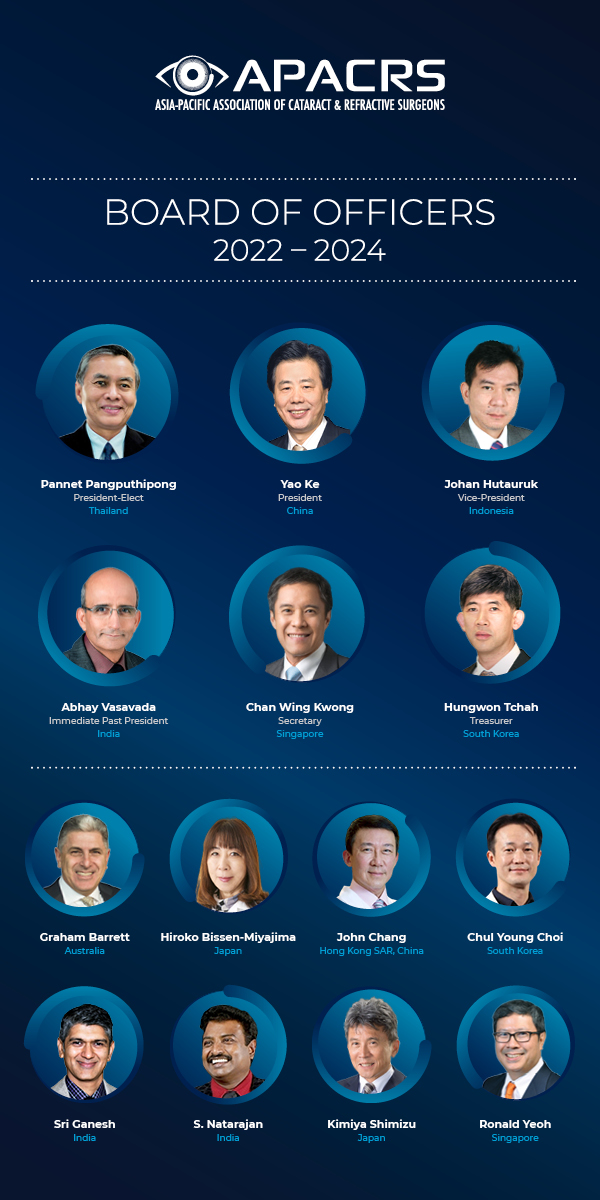
 EyeSustain Update
EyeSustain Update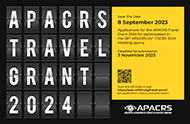 2024 APACRS TRAVEL GRANT
2024 APACRS TRAVEL GRANT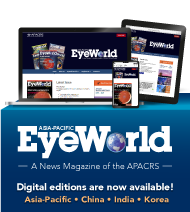 Digital EyeWorld
Digital EyeWorld VOL. 39 (2023), ISSUE 3
VOL. 39 (2023), ISSUE 3  Membership Information
Membership Information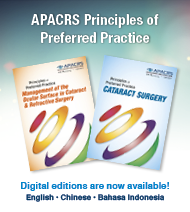 APACRS Principles of Preferred Practice
APACRS Principles of Preferred Practice